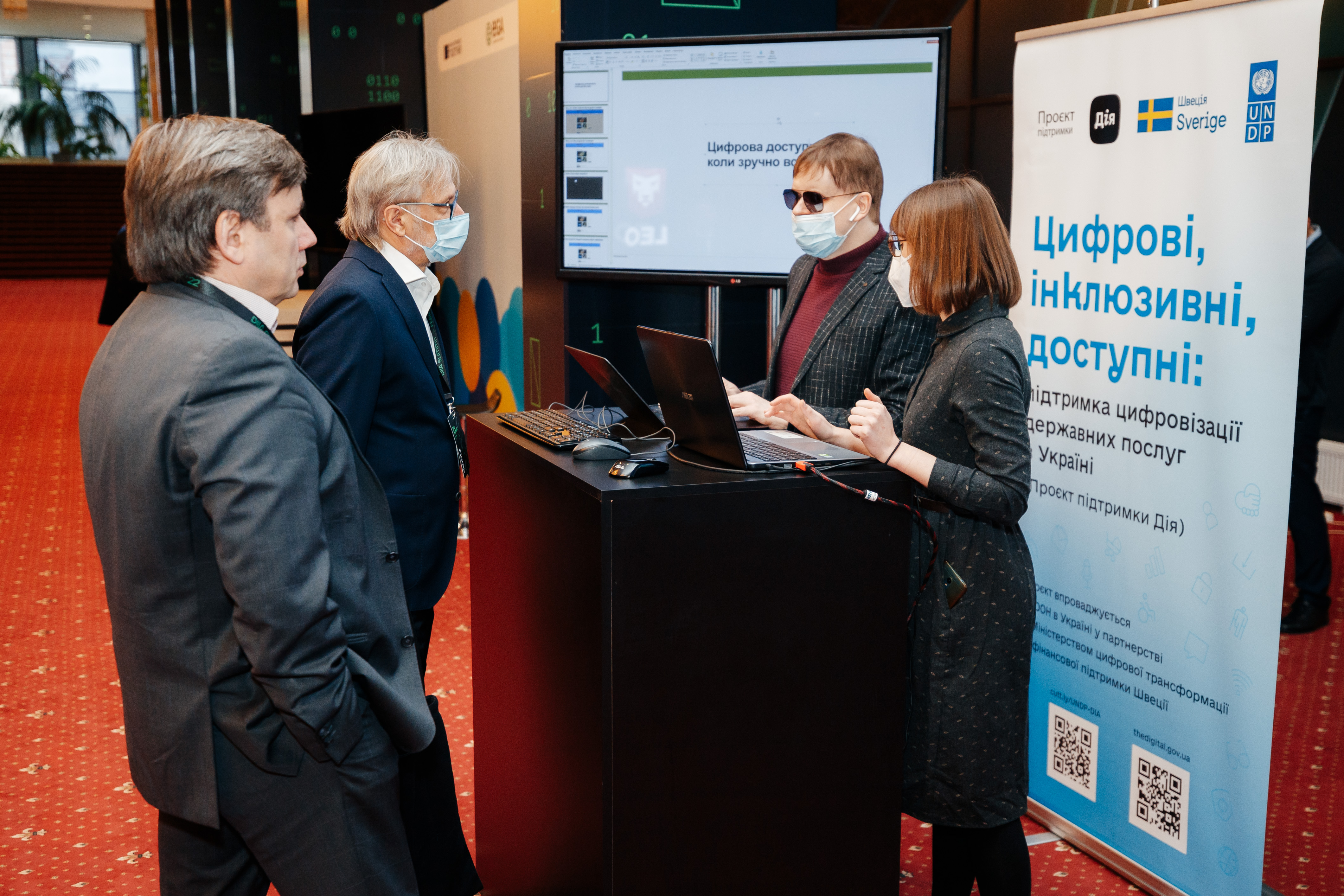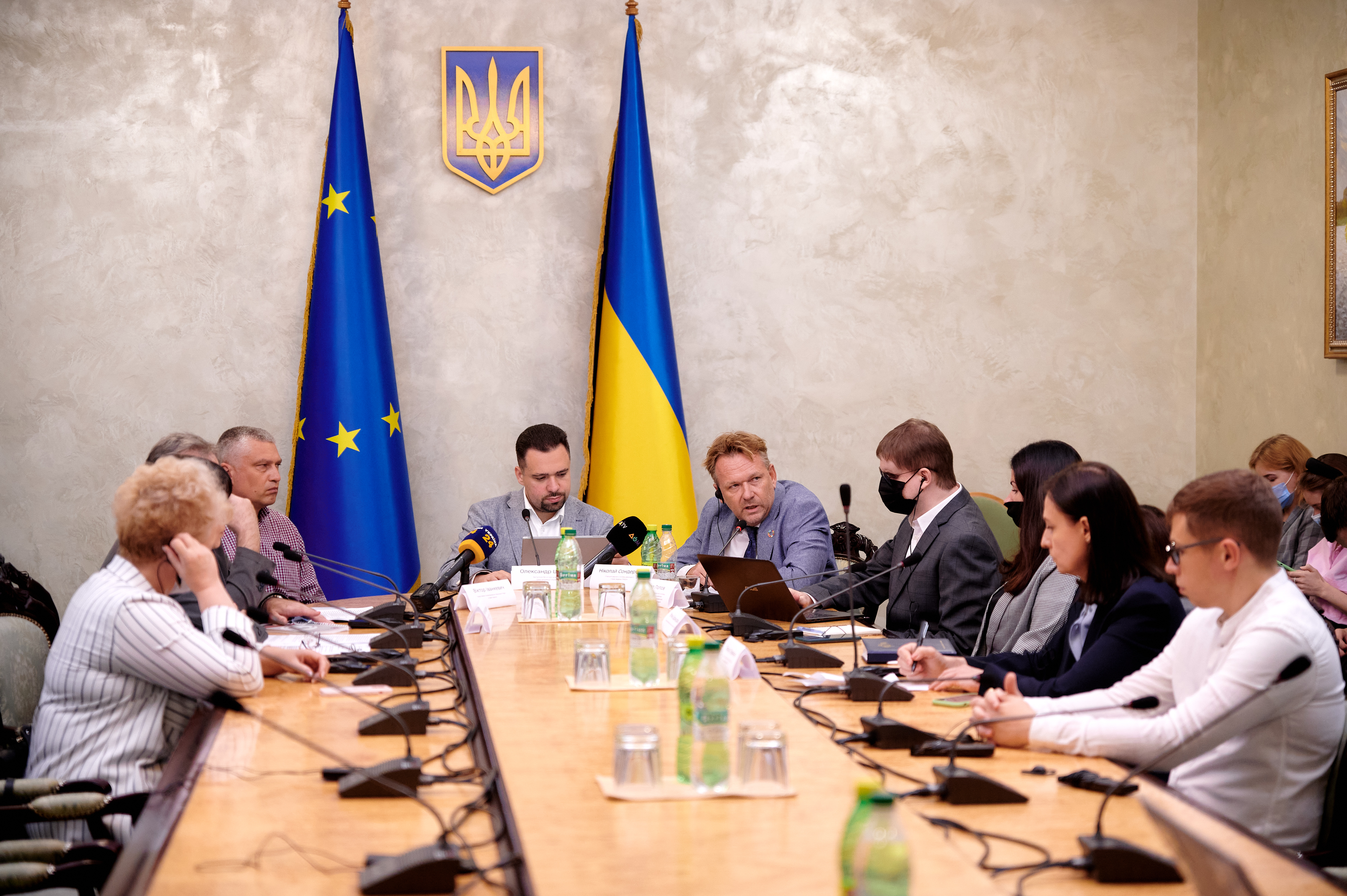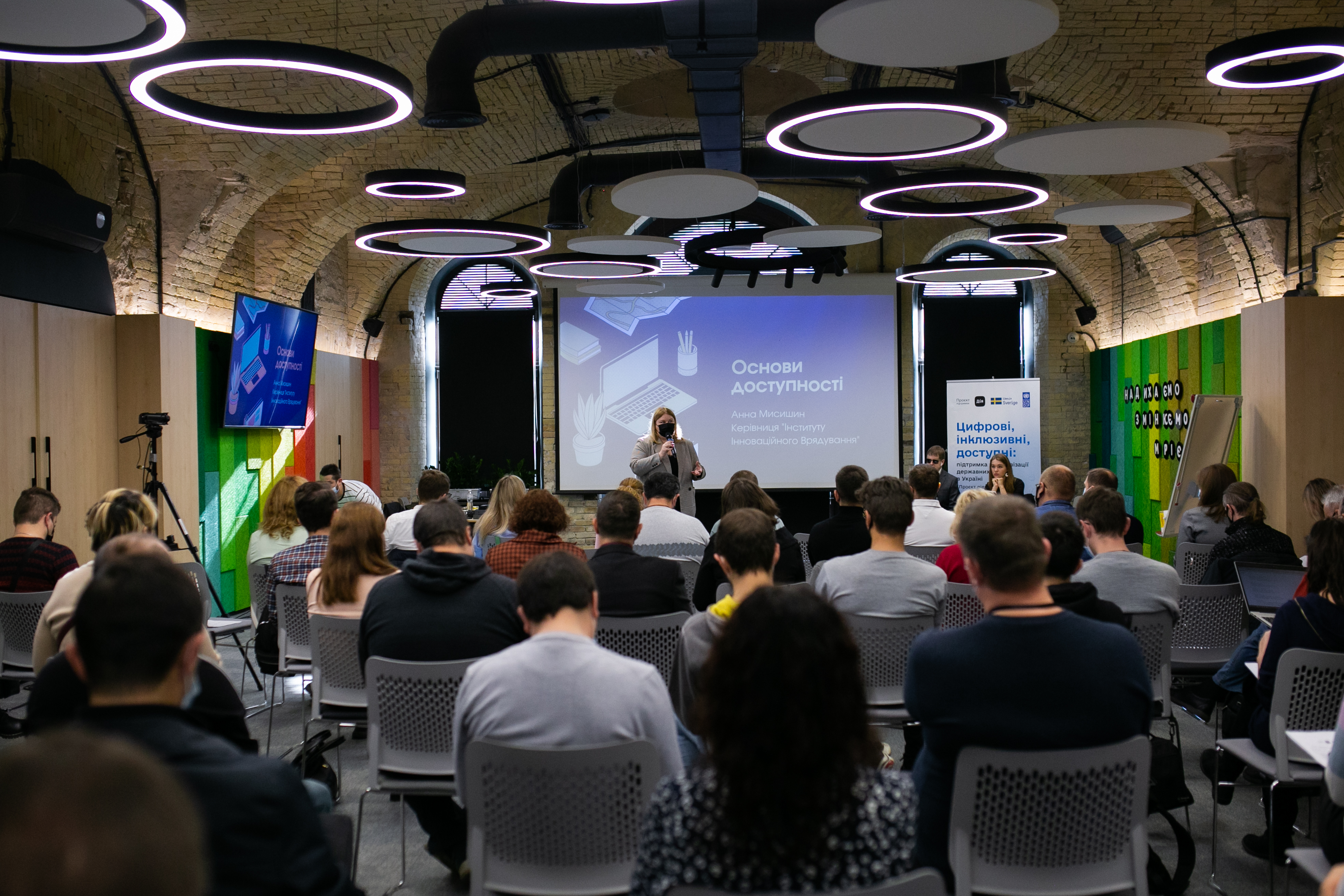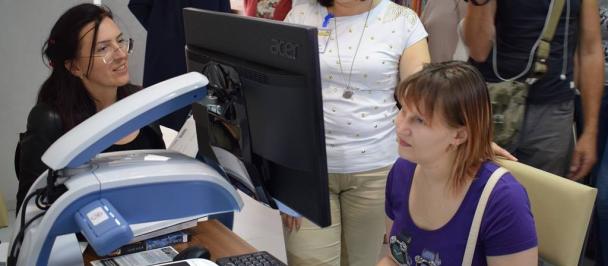The United Nations Development Programme (UNDP) in Ukraine, with the support of Sweden and together with government partners, takes a comprehensive approach to increasing the web accessibility of government resources so all citizens, including people with disabilities, can use them.
Promoting web accessibility: Working to make government websites in Ukraine accessible to everyone
December 3, 2022

UNDP experts help visitors to the Diia Summit check the accessibility of their sites. Kyiv, February 2022.
The International Day of Persons with Disabilities is marked on 3 December. It’s a day to talk about the obstacles faced by people with disabilities realizing their rights on an equal basis with other people – and the steps needed to minimize them. However, not enough attention is devoted to this topic by society, with many thinking the problem of accessibility concerns only a small circle of people. But is that really the case?
In 2021, there were 2.7 million people with disabilities in Ukraine. But that’s only those who are officially registered as such, and the real number is actually much higher. Every day, they deal with barriers that make it much more difficult – even impossible – to do simple things, like ordering a taxi using a mobile app where the colour contrast makes it difficult to read text, or withdrawing money from an ATM where all the writing on the screen is too small. In fact, such situations have probably happened to everyone, so these are not just obstacles for people with disabilities, but obstacles that each of us faces as a result of inconvenient (poorly designed) environments or products. This applies in particular to the digital technologies world.
While people with disabilities usually make up only a small part of an electronic resource's users, up to 50 percent, on the other hand, are people with reduced mobility, or those in challenging circumstances: those who can see, but poorly; those who can hear, but who cannot turn on the sound in the video (because they are in public transport, for example); and those with an injured hand, or busy hands. If a digital resource is not accessible enough, many customers might not be able to use it. Hence, digital transformation may further exacerbate inequalities and abuses of human rights, especially for vulnerable populations.
In order for all of them to find using websites and mobile applications convenient, these resources must have a sufficient level of web accessibility. This is especially so for state digital products, for which, unlike business websites, there is no alternative. Unfortunately, not all state web resources in Ukraine are accessible enough yet.
What is the situation with web accessibility in the public sector?
In line with the UNDP Digital Strategy, which promotes inclusive and gender-sensitive approaches, the organization initiated the expert analysis of 82 public websites that provided electronic services for citizens in 2020. A year later the study was repeated, with 100 websites of executive authorities being tested. The results showed that government websites in Ukraine are not fully accessible.
The research helped clarify the situation with web accessibility in the public sector, but what has to be done to solve this problem in Ukraine, and what is the international experience in this area? To find out, we also analysed how the accessibility of government agencies’ mobile applications is regulated in the countries that are leaders in the field of web accessibility.
All of the studies came to a similar conclusion: Ukrainian legislation in the field of digital accessibility needs to be harmonized with European standards. Therefore, among other things, the authors recommended that Ukraine should adopt one of the leading accessibility standards – the European EN 301 549 – as a state standard.
Most of the requirements that take into account the needs of users are provided in the Web Content Accessibility Guidelines (WCAGs). They describe in detail how web content should be presented in order to be accessible to the maximum number of people. In Ukraine, the state standard[1] regulating web accessibility was adopted in 2016, and it became mandatory for use by the executive authorities only in 2019.
At the same time, the Ukrainian national standard was based on the previous version of the WCAG 2.0 guideline, and there was no translation into Ukrainian, and therefore, it was not fully accessible to developers. The European standard EN 301 549 is based on the newer version of the WCAG 2.1 guideline, which has been used by European legislation for several years.
New government standard and translation of worldwide web accessibility guidelines
The recommendations were accepted, and the Ministry of Digital Transformation of Ukraine, with the support of UNDP, set up a new web accessibility standard. It came into force on 15 June 2022.
[1] DSTU (Ukrainian State Standard) ISO/IEC 40500:2015 Information technology. Web Content Accessibility Guidelines W3C (WCAG) 2.0

The Ministry of Digital Transformation and UNDP present the results of two studies on the web accessibility of government resources at a meeting in Kyiv in September 2021.
The new Ukrainian standard DSTU EN 301 549:2022 “Information technology. Requirements for the Accessibility of ICT Products and Services” completely duplicates the eponymous EU standard. The newer version of WCAG 2.1 guidelines, on which both standards are based, contain several new criteria that developers are required to meet in order to ensure their products are accessible. In particular, the new state standard contains requirements for mobile applications and electronic documents. The previous version was only applicable to websites.
This is an important step, especially considering the fact that many electronic services in Ukraine are developed following the mobile-first principle, that is, they are primarily created for mobile applications to ensure ease of use. For example, this was the case with the service for registration as internally displaced persons and for the submission of an application for monthly targeted assistance in the Diia application, which was developed in April this year by the Ministry of Digital Transformation together with the Ministry of Social Policy of Ukraine and with the support of UNDP and Sweden.
In addition to the standard itself, the Ministry of Digital Transformation, together with UNDP experts, also developed a draft resolution that will make compliance with the requirements of the standard mandatory for all levels of executive authorities. The resolution is under consideration by the Cabinet of Ministers of Ukraine, and after its adoption all new government web resources in Ukraine – websites and mobile applications – will be developed in accordance with the new requirements. A transition period for changing and adapting existing web resources will also be provided.
This time, at the initiative of the DIA Support project, the WCAG 2.1 guidelines were also translated into Ukrainian so that it would be easier for national developers to apply them. The translation has already passed the stages of expert and public discussion, and is now at the final stage of approval by the World Wide Web Consortium (W3C), which actually developed the WCAG guidelines.
Tools for self-checking web accessibility
In both of the mentioned studies of government websites, the authors compiled lists of the most common accessibility errors that they noticed on the tested resources. Therefore, their developers received a list of key points to which attention should be paid when creating or redesigning the web resources of their institutions, and which are understandable even without special training.
For example, often the creators of web products do not make sure there is sufficient contrast between the colours of the text and the background, due to which they easily merge with each other and make it difficult for users to read, and either do not set the language of the page or set it incorrectly. In addition, they forget to add alt text to images, which makes it impossible for screen reader users to find out what is shown in pictures. A screen reader is a special utility that renders all content from a screen as speech, and also operates on many mobile phones. With its help, blind people can use the Internet and access electronic documents.
By the way, the monitoring of the basic accessibility of 100 executive authorities’ web sites was done using a methodology specially developed for this purpose. It contains 10 indicators based entirely on the above-mentioned WCAG principles, and also offers recommendations on how to correct errors if certain indicators are not complied with. To use this technique and check the basic accessibility of the site, no special knowledge is required – simple tools for automatic site scanning and simple manual tests are enough.
These tips are useful both for those who already have a site and for developers of new web resources when making sure that as many people as possible can use the site. Therefore, this technique can be used by government bodies in order to independently analyse and correct errors in the basic accessibility of their web resources.
Increasing understanding of civil servants
However, the simplicity of these web accessibility self-testing mechanisms does not negate the fact that knowing how to fix web accessibility errors is important. Developers in central and local government – both of web resources and related policies – need to understand both the importance of making their products web accessible to users, and understand how to achieve it. Aiming to support our partners in their holistic digital transformation efforts and advocate for inclusive digital solutions, UNDP, with the support of Sweden, organized a number of educational training sessions and practical workshops for representatives of various state authorities.

Civil servants and representatives of government institutions from all over the country learn the basics of web accessibility at a training session organized by UNDP and Sweden in Kyiv in October 2021.
For example, in October 2021, the UN Development Programme in Ukraine with the support of Sweden brought together more than 200 civil servants from the central executive authorities for a specialized training course on web accessibility. These employees were responsible for posting content on their organizations’ official web resources and social networks, website administration, and IT solutions development. The topic discussed were wide-ranging: from the basics of web accessibility (how to talk about people with disabilities, how they use sites, why web accessibility is important, and what international standards exist for it) to specialized advice for designers and content developers.
The initiative was repeated the following year but more in-depth training sessions were held – this time specifically for web developers who work on the implementation of state electronic services, and communication specialists at a number of Ukrainian ministries and state enterprises. Experts shared recommendations on how to create accessible texts, website design, and interfaces. For example, there was training in how exactly to write alternative text, design tables and formulas, and how to mark headings correctly. They also provided real-life examples of key accessibility mistakes, and showed how to avoid them.
As a follow-up, during the 10th Civil Society Development Forum in December 2021 a workshop on web accessibility was held in Kyiv. All visitors could see live how people with visual impairments use web resources with the help of a screen reader, and see what errors by developers can create virtual barriers for them. UNDP experts also helped forum visitors test their sites and check if they had any accessibility errors.
A similar event was held at the Diia Summit in February 2022. The Diia Summit is the main event of the country in the field of digitization, organized by the Ministry of Digital Transformation, which UNDP and Sweden have supported since its inception. Programme experts prepared interactive exercises related to web accessibility, and summit attendees could see how certain web accessibility practices work, and why they are important.
Previously, UNDP supported training on how people with visual impairments can look for work on the Internet. Screen reader users tested popular office programmes and job search services and demonstrated the practical difficulties they face with well-known specialized resources. The training participants – representatives of all sides: people with visual impairments, employers and representatives of online job search services – were able to discuss how to make the digital workplace more inclusive and convenient for everyone.
We’re not stopping there: As digital technologies proliferate ever more quickly, UNDP is striving to help ensure that digital ecosystem is built in an inclusive manner so that it empowers users. We’re continuing to work to raise awareness about web accessibility among citizens and those government officials who make decisions about and develop digital products.
After all, an accessible state website or a mobile app is not an end goal in itself. The ultimate, most important objective is that the entire range of public web services that are actively being developed in the country are available to all citizens, so that digital transformation addresses the needs of all people, including the most vulnerable, and so that no one is left behind.
All the above-mentioned initiatives were carried out within the framework of the project “Digital, inclusive, accessible: Support for the digitalization of public services in Ukraine” (DIA Support project), which UNDP in Ukraine is implementing in partnership with the Ministry of Digital Transformation of Ukraine with the financial support of Sweden.
Authors:
- Olena Ursu, UNDP Ukraine Programme Specialist, Democratic Governance Team Leader
- Olha Matiahina, PR and Communications Associate, DIA Support project

 Locations
Locations

